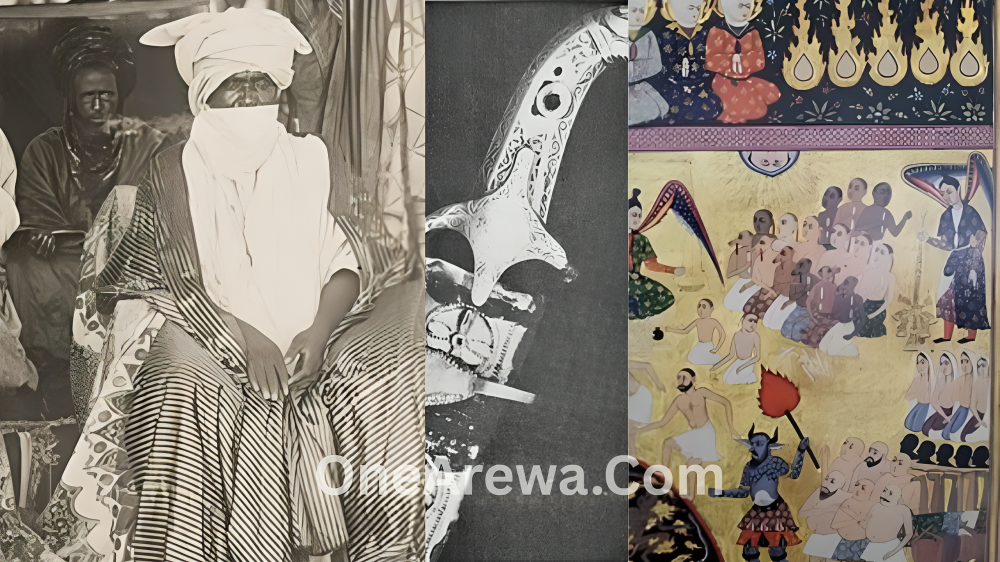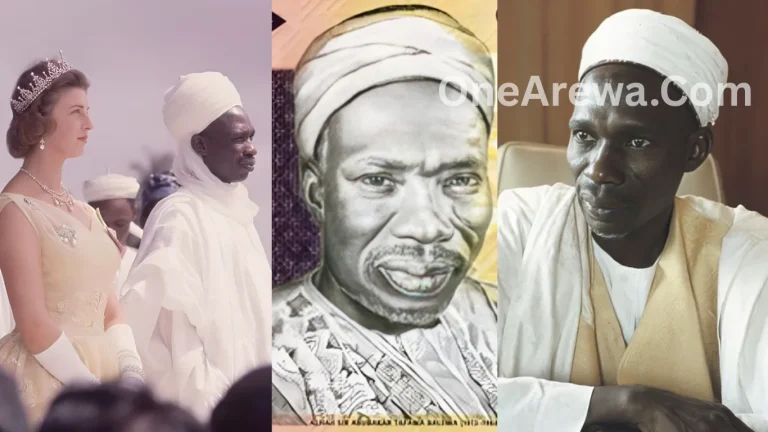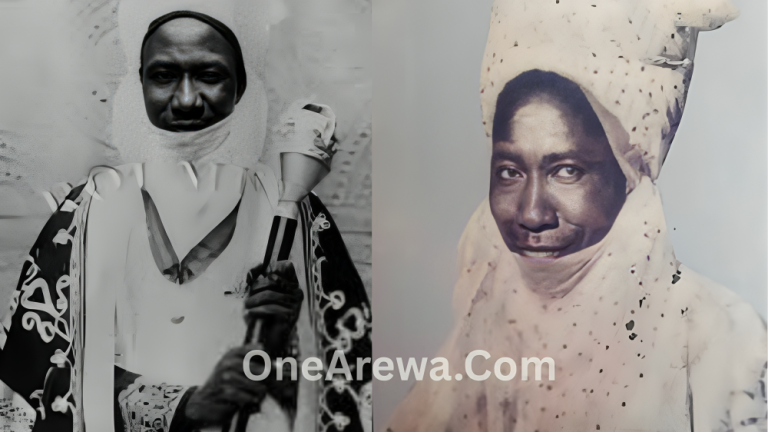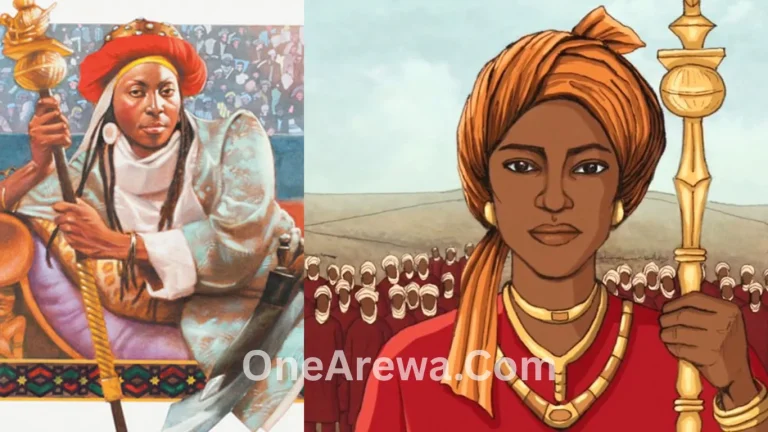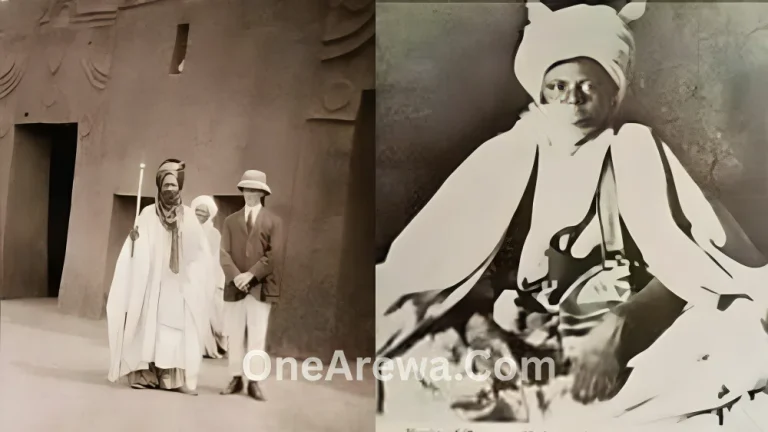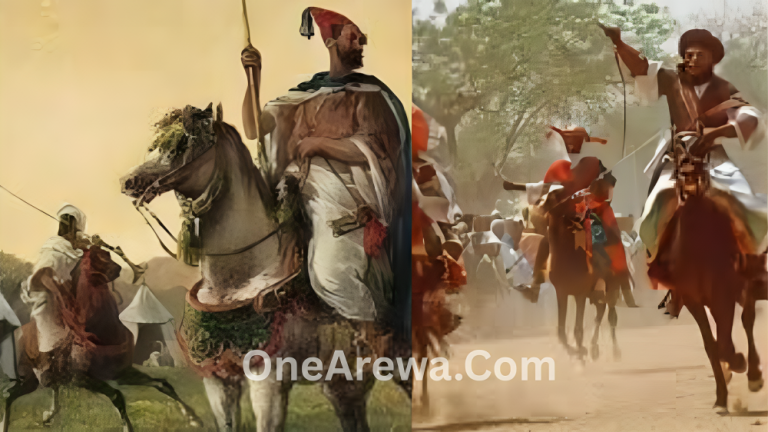Emir Muhammadu Kanta of Gwandu: Respected Leader, Peacebuilder, and Champion of Community Development
Emir Muhammadu Kanta of Gwandu: Respected Leader, Peacebuilder, and Champion of Community Development
Emir Muhammadu Kanta of Gwandu, also known as Kanta Kotal (r. 1517–1561), was a powerful 16th-century Hausa warrior who founded the Kebbi Empire after rebelling against the Songhai Empire.
Originally a general under Songhai, he broke away and established an independent state with its capital at Surame.
Kanta expanded Kebbi through military campaigns, defeating many Hausa states and resisting invasions from Songhai and the Kanem-Bornu Empire.
In one famous event, he tricked the Bornu army into retreating by propping up dead soldiers to appear as if they were still smiling and ready to fight. This gave rise to the Hausa saying “Dariya ba loto.”
He built several capitals, including Birnin Leka, Gungu, Silame, and Surame.
Surame became the most fortified and was known for its unique Islamic-inspired justice system called the Siradi, where accused persons crossed a narrow bridge to prove their innocence.
Kanta died after being struck by a poisoned arrow during a campaign against Bornu. To protect his grave from enemies, his men built 12 decoy tombs, and his real burial place remains unknown.
He is remembered as a brilliant warrior, lawgiver, and city-builder, and his legacy lives on in the historical ruins of Surame and the stories of Kebbi’s greatness.
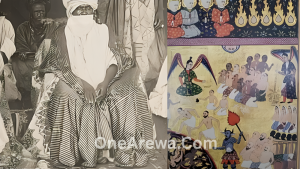
Emir Muhammadu Kanta of Gwandu Wikipedia
| Fact | Details |
|---|---|
| Full Name | Muhammadu Kanta |
| Title | Emir of Kebbi (Founder of Kebbi Kingdom) |
| Reign | Early to mid-16th century (approx. early 1500s to late 1500s) |
| Origin | Son of Makata, from Bawa in Katsina Emirate |
| Known for | Founding the Kebbi Kingdom, breaking away from the Songhai Empire |
| Major Adversaries | Songhai Empire, Kanem-Bornu Empire |
| Famous Battle Tactic | Used dead soldiers with slit lips to intimidate Bornu army |
| Key Towns Founded | Surame (final capital), Birnin Leka, Gungu, Silame |
| Military Achievements | Defeated Songhai forces; repelled Bornu army; won battles |
| Death | Died from a poisoned arrow wound at Jiruwa near Katsina |
| Legacy | Fearless warrior, strategic leader, secured Kebbi’s independence |
| Cultural Impact | Surame Palace and the city remain historic; legends of supernatural events |
| Hausa Phrase Origin | “Dariya ba loto” (laughter without end) from the Bornu siege tactic |
Emir Muhammadu Kanta of Gwandu’s Early Life
Emir Muhammadu Kanta of Gwandu was born as the eldest son of Makata, who migrated from the east to Bawa, a settlement located in present-day Sokoto, Nigeria, which was part of the Hausa Kingdom of Katsina at the time.
Makata was appointed the village head and given the title of Magaji.
He married Tamatu, a princess from Katsina, and together they had two sons, with Muhammadu Kanta being the eldest.
However, upon Makata’s death, Kanta was unexpectedly passed over for succession as village head, a position that many would have assumed he would inherit as the firstborn.
Disappointed and frustrated by this decision, Kanta decided to leave his home. He became a cattle grazer and started to travel extensively across Hausaland.
His journey took him westward through several Hausa states, including Gobir and Zamfara, before crossing the Rima River.
Eventually, he settled in a village whose exact identity is debated among historians, some suggest it was Surame, while others argue it was Leka.
During this period, Kanta became well known for his extraordinary physical strength and combat skills.
He excelled in boxing and wrestling, reportedly defeating every challenger who came his way.
His unmatched prowess earned him the epithet ‘Kotal,’ which translates to ‘no challenger.’
Kanta was also notable for his distinctive appearance in battle or combat, wearing a white ram’s skin wrapped around his loins and arm, while his fighting hand was wrapped with the hairs from a white ram’s tail.
This attire became symbolic of his strength and fearlessness.
Check Out: Emir Abubakar of Hadejia: The Visionary Leader Behind Hadejia’s Cultural and Community Development
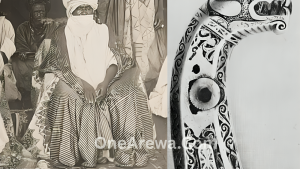
Emir Muhammadu Kanta of Gwandu Ruler of Kebbi
After establishing himself as a formidable warrior and gaining recognition for his strength and leadership qualities, Emir Muhammadu Kanta of Gwandu rose to become the ruler of Kebbi.
He founded and consolidated a powerful state by uniting various territories and forging a strong, well-organized empire in the region.
Kanta’s reign marked a period of military expansion and political consolidation.
He conquered and fortified several key towns, establishing three major capitals: Birnin Leka, Gungu, and Silame.
Birnin Leka, his first capital, was created by merging nine separate settlements into a single fortified city.
Gungu, meaning “the oasis,” was built around a house he constructed for his wife Makulo, an Aïr princess of royal descent.
Silame was founded to balance power and residence for his senior wife, Magajiya Lame.
Kanta’s most famous and final capital was Surame, a vast and strategically designed metropolis consisting of seven concentric towns, each with seven gates, totaling 49 gates with cavalry stables at almost every gate except the innermost.
Surame was heavily fortified with massive walls, parts of which still stand today. It became the political, military, and economic heart of his empire.
As ruler, Kanta commanded tribute in men and wealth from the states under his control, extending his influence over the surrounding regions.
His strict enforcement of tribute included punitive measures; for instance, when the Tuareg subjects displeased him, they were forced to draw water from their desert homeland far away, and when the Nupe people delayed tribute, they were ordered to mix shea butter instead of water to build part of Surame’s walls, resulting in an especially strong fortification.
Kanta also implemented unique judicial practices, such as the trial by ordeal at Surame’s narrow “Siradi” section of the city walls, where accused individuals were made to cross a perilous bridge; success meant innocence, failure indicated guilt.
Throughout his reign, Kanta was involved in intense rivalry and warfare with neighboring powers, particularly the once-dominant Kanem-Bornu Empire, defending Kebbi’s sovereignty and expanding its reach.
Emir Muhammadu Kanta of Gwandu War with Bornu
During Emir Muhammadu Kanta of Gwandu’s reign in the 16th century, one of his greatest challenges came from the powerful Kanem-Bornu Empire, which had historically been the suzerain over much of Hausaland.
The Bornu rulers, known as Mais, saw Kanta’s rising Kebbi Empire as a direct threat to their control over the lucrative trans-Saharan trade routes.
A notable conflict likely occurred during the reign of Mai Idris Katakarmabi (1504–1526) or Mai Ali II (1545–1546), when the Bornu army advanced across Hausaland, chasing Kanta’s forces back to the Kebbi capital, Surame.
The Bornu laid siege to Surame and inflicted heavy casualties on the defenders.
However, as the Bornu army prepared for a final assault on the city walls, they were shocked to see the defenders standing confidently and grinning.
Unknown to them, many of these defenders were actually dead soldiers propped up with their lips slit to create the illusion of smiling, a psychological tactic designed by Kanta.
This eerie display convinced the Bornu commander that the Kebbi defenders outnumbered his forces, causing him to lift the siege and retreat.
This incident gave rise to the Hausa phrase “dariya ba loto,” meaning “laughter without end,” symbolizing deceptive bravery.
The rivalry continued intensely throughout Kanta’s rule. At one point, Mai Muhammad Aminami of Bornu reportedly assembled an army of about 100,000 men to challenge Kanta’s forces, indicating the scale and seriousness of the conflict.
This persistent warfare may have motivated Mai Muhammad Aminami to form an alliance with Turgut Reis, Pasha of Tripoli, in the 1550s, seeking external support against Kebbi.
Later, Kanta launched a retaliatory campaign into Bornu, winning several battles (reportedly seven pitched battles) and pushing his forces close to the Bornu capital.
However, on his return journey, Kanta was wounded near Katsina by a poisoned arrow and died from his injuries at Jiruwa.
Check Out: Shehu Muhammad al-Amîn al-Kanemi (1776 – 8 June 1837)
Emir Muhammadu Kanta of Gwandu Fortified Towns
Emir Muhammadu Kanta of Gwandu was not only a formidable warrior and ruler but also a strategic city-builder who established and fortified several key towns that served as political and military centers of his empire.
After capturing the settlement that became Birnin Kebbi, Kanta, together with his wife Makulo (an Aïr princess), built his first capital, Birnin Leka.
This city was formed by merging nine smaller settlements into one and was protected by strong defensive walls.
Another significant town founded by Kanta was Gungu, meaning “the oasis.” Located about thirty miles west of Sokoto, the ruins of its massive stone and laterite walls still stand today.
According to tradition, Kanta’s wife Makulo, upset at her lower status compared to Kanta’s first wife Lame (whose parents were commoners), fled west of Gungu and wept beneath a baobab tree.
To console her, Kanta ordered a house to be built at that spot, around which the town of Gungu developed.
To maintain balance among his wives, Kanta also founded Silame, a third-walled town to the north, as a residence for his senior wife Lame.
Kanta’s most famous capital was Surame, his final seat of power. Surame grew into a vast metropolis, made up of seven concentric towns, each with seven gates, totaling 49 gates with stables for cavalry at nearly every gate except the innermost town.
Surame’s defenses were legendary. The city’s walls were extremely strong, and a section of the wall was constructed with shea butter instead of water (on Kanta’s orders) as a form of punishment and also to reinforce the wall’s strength, after the Nupe people delayed their tribute.
Near the palace in Surame stood the Siradi, a narrow, perilous passage only 18 inches wide, where Kanta would test the guilt or innocence of accused individuals: those who crossed it successfully were freed, while those who failed fell to traps or wild beasts.
Kanta’s palace in Surame became a place of legend and local myths, with stories of ghostly drums, neighing supernatural horses at night, and a well whose chain mysteriously rattled every Friday. These tales reinforced Kanta’s mystique and authority.
Emir Muhammadu Kanta of Gwandu’s Death
Years after successfully defending Surame from the Bornu siege, Emir Muhammadu Kanta of Gwandu launched a retaliatory campaign against the Kanem-Bornu Empire.
He is said to have won seven pitched battles against the Mai’s army, pushing deep into Bornu territory but ultimately halted just short of their capital.
On his return journey to Surame, Kanta was involved in a skirmish near Rimin dan Ashita, a settlement close to Ingawa in Katsina.
During this fight, he was struck by a poisoned arrow and succumbed to his wounds at a place called Jiruwa.
To keep the location of his burial secret and protect his legacy, Kanta’s remains were transported back to Kebbi with twelve tombs constructed along the route to confuse anyone seeking his true resting place.
His immense wealth is believed to have been buried beneath a large flat-topped hill near Gungu, one of the towns he founded.
Emir Muhammadu Kanta’s legacy
Emir Muhammadu Kanta of Gwandu left a lasting legacy as a fearless warrior, shrewd statesman, and visionary leader who carved out Kebbi as an independent and powerful kingdom in the 16th century.
His military prowess secured Kebbi’s sovereignty against mighty empires like Songhai and Bornu, inspiring generations with his tactical brilliance and unyielding spirit. Kanta’s establishment and fortification of key towns such as Surame showcased his dedication to strong governance and community development.
His use of clever psychological warfare during the Bornu siege remains a celebrated tale of strategic ingenuity in Hausa history.
Culturally, his reign is marked by legends and traditions that continue to enrich the heritage of Kebbi and Hausaland.
Even after his death, his influence persisted through the political stability and fortified cities he founded, cementing his place as a symbol of Hausa resilience and leadership.
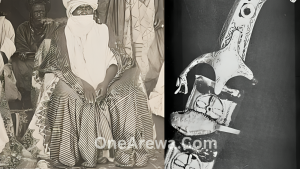
FAQs
1: Who was Emir Muhammadu Kanta of Gwandu?
He was the founder and first ruler of the Kebbi Kingdom in the early 16th century, known for his military prowess, strategic leadership, and role in establishing a strong, independent state in Hausaland.
2: What was Emir Muhammadu Kanta of Gwandu’s early life like?
Born as the eldest son of Makata in Bawa, Katsina, Kanta was denied succession after his father’s death, which led him to become a skilled warrior and cattle herder, eventually founding Kebbi.
3: How did Emir Muhammadu Kanta of Gwandu challenge the powerful empires of his time?
He led successful military campaigns against the Songhai Empire and the Kanem-Bornu Empire, breaking Kebbi away from Songhai control and repelling Bornu’s invasions.
4: What was Emir Muhammadu Kanta of Gwandu’s most famous military tactic against Bornu?
During the siege of Surame, Kanta propped up dead soldiers with slit lips to create the illusion of grinning defenders, intimidating the Bornu army and forcing their retreat. This inspired the Hausa phrase “dariya ba loto,” meaning “laughter without end.”
5: Which towns did Emir Muhammadu Kanta of Gwandu found and fortify?
He established several fortified towns, including Surame (his final capital), Birnin Leka, Gungu, and Silame, each serving strategic and political purposes within his kingdom.
6: How did Emir Muhammadu Kanta of Gwandu rule and administer his kingdom?
Kanta demanded tribute in men and wealth, used strict justice systems like the “Siradi” narrow wall test for guilt, and maintained strong military defenses.
7: How did Emir Muhammadu Kanta of Gwandu die?
He was wounded by a poisoned arrow during a skirmish near Katsina and died at Jiruwa. His burial place was kept secret to protect his legacy.
8: What is Emir Muhammadu Kanta of Gwandu’s lasting legacy?
Kanta is remembered as a fearless leader who secured Kebbi’s independence, built impressive fortified cities, and became a symbol of courage, strategic brilliance, and community leadership in Hausa history.
9: Are there any legends or cultural impacts associated with Emir Muhammadu Kanta of Gwandu?
Yes, Surame’s ruins remain a site of historical reverence, with legends of ghostly drums and supernatural events linked to his palace, enhancing his mythical status.
10: How is Emir Muhammadu Kanta of Gwandu remembered today?
He is celebrated as a foundational figure in Kebbi’s history, embodying strength, justice, and peacebuilding, inspiring pride among the Kebbi people and Hausa communities.
In conclusion
Emir Muhammadu Kanta of Gwandu stands as a towering figure in West African history, renowned for his exceptional leadership, military genius, and statecraft.
From humble beginnings marked by personal setbacks, he rose to found and fortify the powerful Kebbi Kingdom, successfully challenging dominant empires like Songhai and Kanem-Bornu.
His legacy is etched not only in the impressive fortified cities he established but also in the enduring stories and cultural traditions that celebrate his courage, justice, and commitment to community development.
Emir Kanta’s life and reign continue to inspire admiration and respect, symbolizing resilience and visionary leadership in the history of Hausaland and beyond.
Check Out: Shehu Usman Dan Fodio: The Islamic Scholar Who Founded the Sokoto Caliphate (1754–1817)
Check Out: General Abdulsalami Abubakar: The Military Leader Who Brought Back Democracy to Nigeria (1998–1999)
